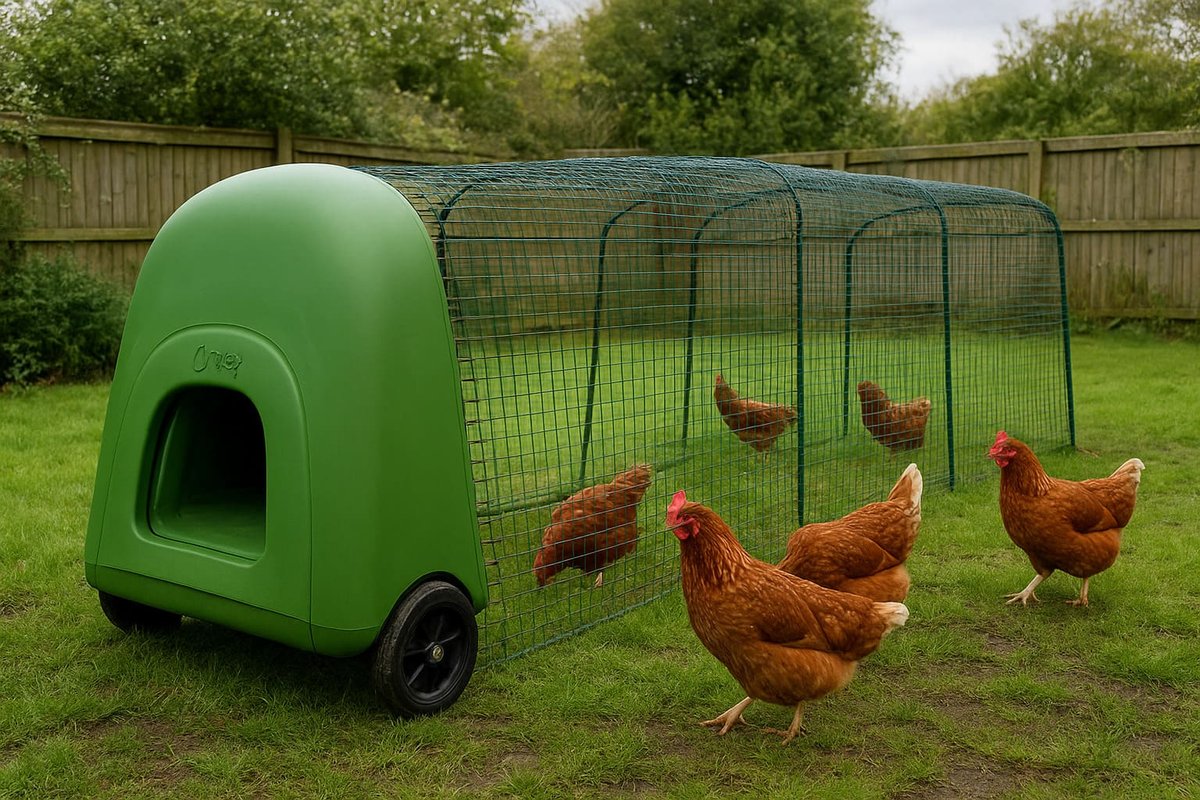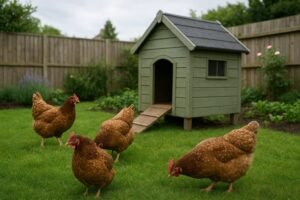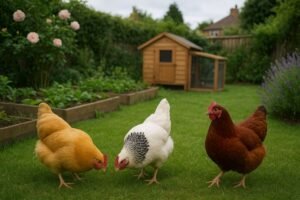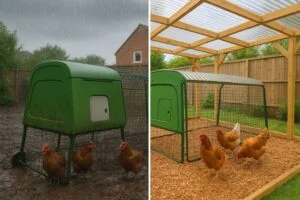Let’s be honest, you saw the price of the Omlet Eglu Cube and your jaw probably hit the floor. I know mine did. “Over £1,100 for a chicken coop?” I thought. “You’ve got to be kidding me.”
As a UK poultry keeper for over seven years, based here in my garden in rural Devon, I was tired of battling rotting wooden coops, the yearly dread of red mite infestations, and waking up in a panic every time I heard a fox. After making my share of common first-time keeper mistakes, I finally found a solution. It’s also important to note that as of October 2024, all keepers must follow DEFRA registration requirements. This is my completely honest Omlet Eglu Cube review, based on years of real-world use with my flock of garden chickens UK style.
I bought this plastic chicken coop with my own money, so there’s no sugar-coating here. I’ll tell you what I love, what annoyed me, and answer the biggest question of all for anyone involved in UK chicken keeping: is this famous coop a game-changer, or just an expensive gimmick?
Omlet Eglu Cube Review Quick Summary
| Feature | Details |
|---|---|
| Capacity | 6 large hens, 8 medium breeds, or 10 bantams |
| Price (Oct 2025) | Approx. £1,122 (coop + 4m run + wheels) |
| Material | UV-stabilised, twin-wall polyethylene plastic |
| Warranty | 10 years |
| Best For | UK keepers wanting a low-maintenance, predator-proof, long-lasting home |
| Cleaning Time | 5-10 minutes weekly (I’m not joking) |
| Assembly Time | 2-5 hours (realistically; Omlet’s 1-hour estimate is optimistic) |
What is an Eglu Cube? Understanding Omlet’s Design
The Omlet Eglu Cube is a modern, plastic chicken coop made by a British company, Omlet. It’s designed to be a low-maintenance and predator-proof coop alternative to a traditional hen house.
Instead of wood that rots in our typical British drizzle, they used a tough, twin-wall insulated plastic. The Eglu Cube is their biggest model, designed as a complete modular coop system. It comes in colours like Leaf Green and Purple, which my neighbour thinks looks like a spaceship for chickens. Honestly, he’s not wrong.
The Core Philosophy: Solving Problems for Keepers
Omlet’s goal wasn’t just to make a plastic box. They aimed to solve the three biggest problems that make people give up on keeping chickens: difficult coop cleaning, relentless pests (like red mites), and the constant threat from fox attacks.
Every feature, from the slide-out droppings tray to the anti-tunnel skirt, is a direct answer to one of these issues. It’s designed for people who want to spend more time enjoying their chickens and less time doing chores.
So, while it looks unconventional, the design is driven by pure function. Now, let’s talk about the experience of actually getting this functional piece of plastic set up in your garden.
First Impressions & Assembly
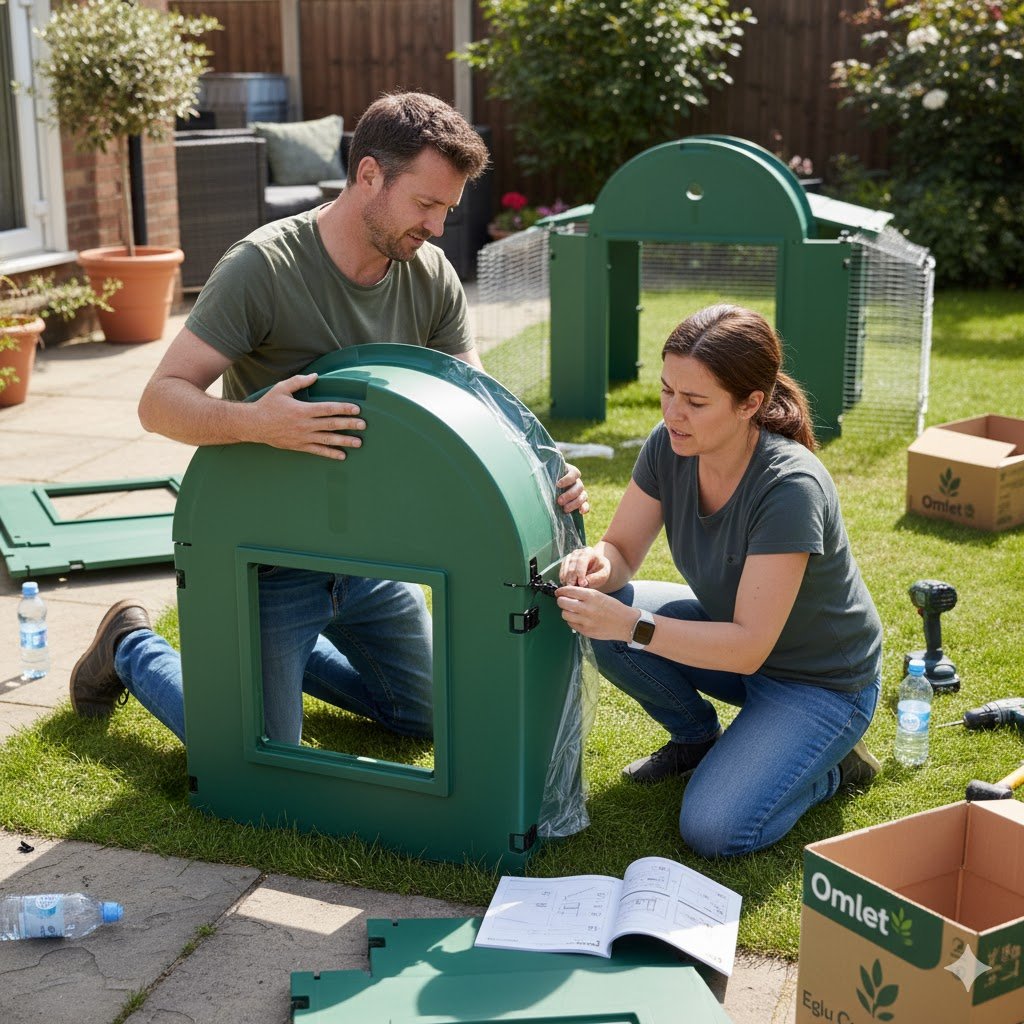
Assembling the Eglu Cube is its most challenging part. My delivery arrived within a week via a standard courier. It came in what felt like a mountain of boxes—I think there were seven in total—and while the cardboard was a bit battered, all the components inside were well-protected and arrived without any scratches.
While Omlet suggests a 1-hour assembly time, real-world experience from myself and other UK keepers shows 2-5 hours is far more realistic, especially for first-time builders. My heart sank a little when I saw all the boxes. It looked overwhelming.
The instructions are like a giant Lego manual—all pictures, very few words. Now, let me be honest: it took my husband and me a solid four hours, and the little plastic clips used to hold the run together were a real pain for my fingers.
My Top Assembly Tips to Avoid Frustration
- Don’t Do It Alone: This is a two-person job. Trying to hold large panels and secure clips by yourself is a recipe for disaster.
- Organise Everything First: Unpack all the boxes and lay out the pieces in groups. This will save you from hunting for parts later.
- Use a Rubber Mallet: A gentle tap with a rubber mallet can help seat the run clips without damaging them or your hands.
- Watch a Video Guide: Omlet has video tutorials on their website. Watching one beforehand gives you a much better sense of the process than the paper instructions alone.
Once it’s built, it’s solid as a rock, but getting there is a real test of patience. With the build finally out of the way, the real question is how it compares to the coops we all know.
Is an Eglu Better Than a Wooden Coop? Direct Comparison
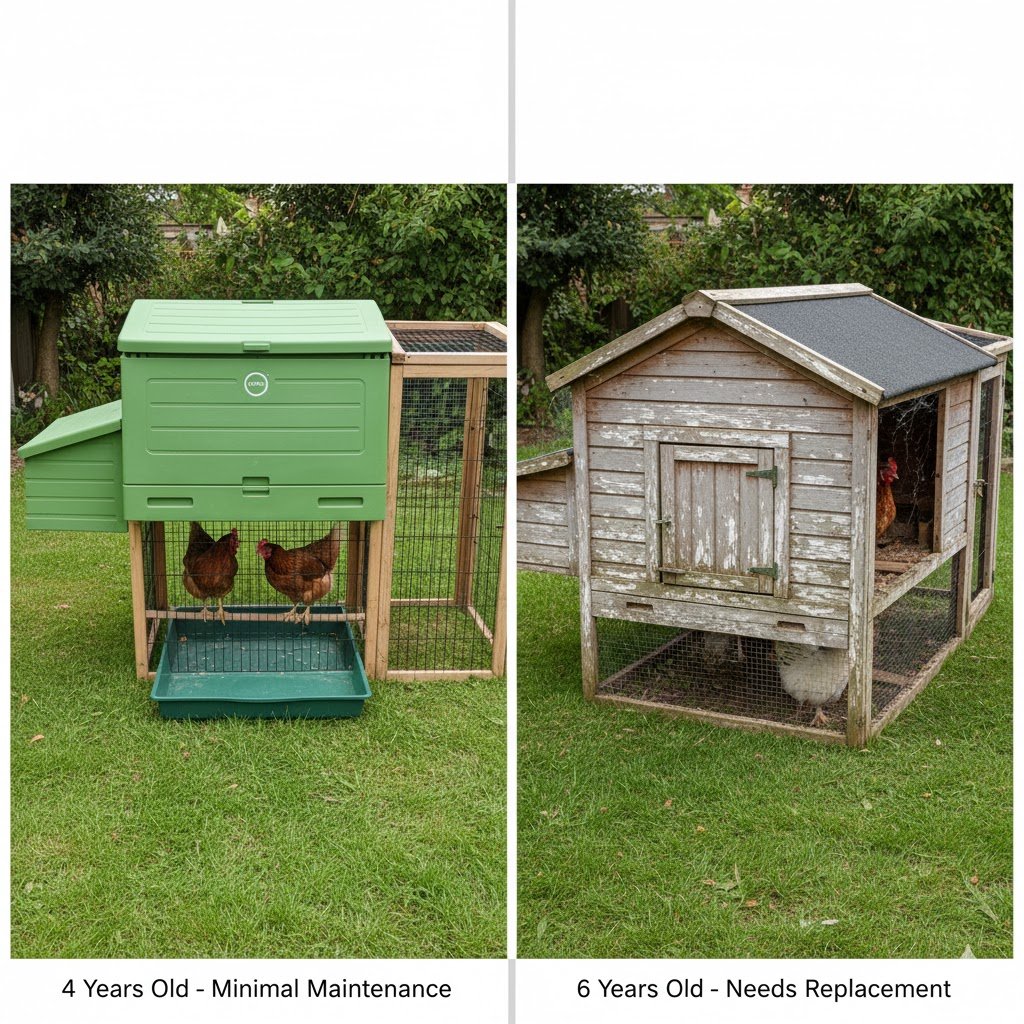
Yes, in my experience, an Eglu Cube is significantly better than a wooden coop for low maintenance, durability, and preventing red mites. This is the core of the wooden coop vs plastic debate.
I’ve had three wooden coops, and every single one ended up a damp, spider-infested mess. They look lovely for the first year, but after a few wet British weather conditions, the wood starts to go soft, the roof leaks, and they become a five-star hotel for red mites.
The Eglu Cube, being plastic, just doesn’t have these problems.
- Cleaning: It’s not even a fair fight. My easy-clean coop takes less time to clean than making coffee. The smooth plastic just hoses down. My last wooden coop took half an hour of scrubbing.
- Red Mites: This is a massive deal. The Eglu is red mite resistant because there are no cracks for them to hide in. That peace of mind is priceless. Learn more about identifying and treating chicken mites to keep your flock healthy. Many keepers also use diatomaceous earth for mite prevention and complement the Eglu’s design by setting up a dust bath area for natural pest control.
- Durability: The plastic just lasts. My wooden coops looked sad after five years. The Eglu is built to go for 15+ years.
While the upfront cost is higher, the Eglu’s practical advantages save you time, money, and stress in the long run. Thinking about durability, let’s look at just how long you can expect this investment to last.
How Long Does an Omlet Eglu Last? Durability & Build Quality
An Omlet Eglu Cube is designed to last for 15+ years, backed by a 10-year warranty, making it far more durable than a typical wooden coop. This is a key factor when considering alternative chicken coops.
It’s made from a seriously tough, UV-resistant plastic, the same kind used for road barriers and industrial tanks. It’s designed as weather-resistant housing that can withstand sunlight without becoming brittle.
Real-World UK Weather Testing
After owning the Eglu for four years (since early 2021), including it surviving Storm Eunice in February 2022 better than my fence did, the colour has faded only slightly, and there are no cracks or weaknesses.
My wooden coops would have needed re-staining twice in that period. The steel run is also well-coated and has resisted rust, even where it constantly sits on damp grass.
10-Year Warranty Explained
The 10-year warranty from Omlet (UK company) covers the main plastic housing and structure against manufacturing defects. This shows their confidence in the product’s longevity, something you rarely see with a traditional hen house. It’s a significant part of the value proposition.
This level of build quality is impressive, but it’s pointless if it’s not the right size for your flock. Let’s talk about how many birds it can realistically hold.
How Many Chickens Fit in an Eglu Cube? Capacity Guide
The Eglu Cube officially holds up to 6 large hens, 8 medium-sized breeds, or 10 bantam chickens. However, based on my experience, I recommend 4-5 large fowl breeds for comfortable year-round housing.
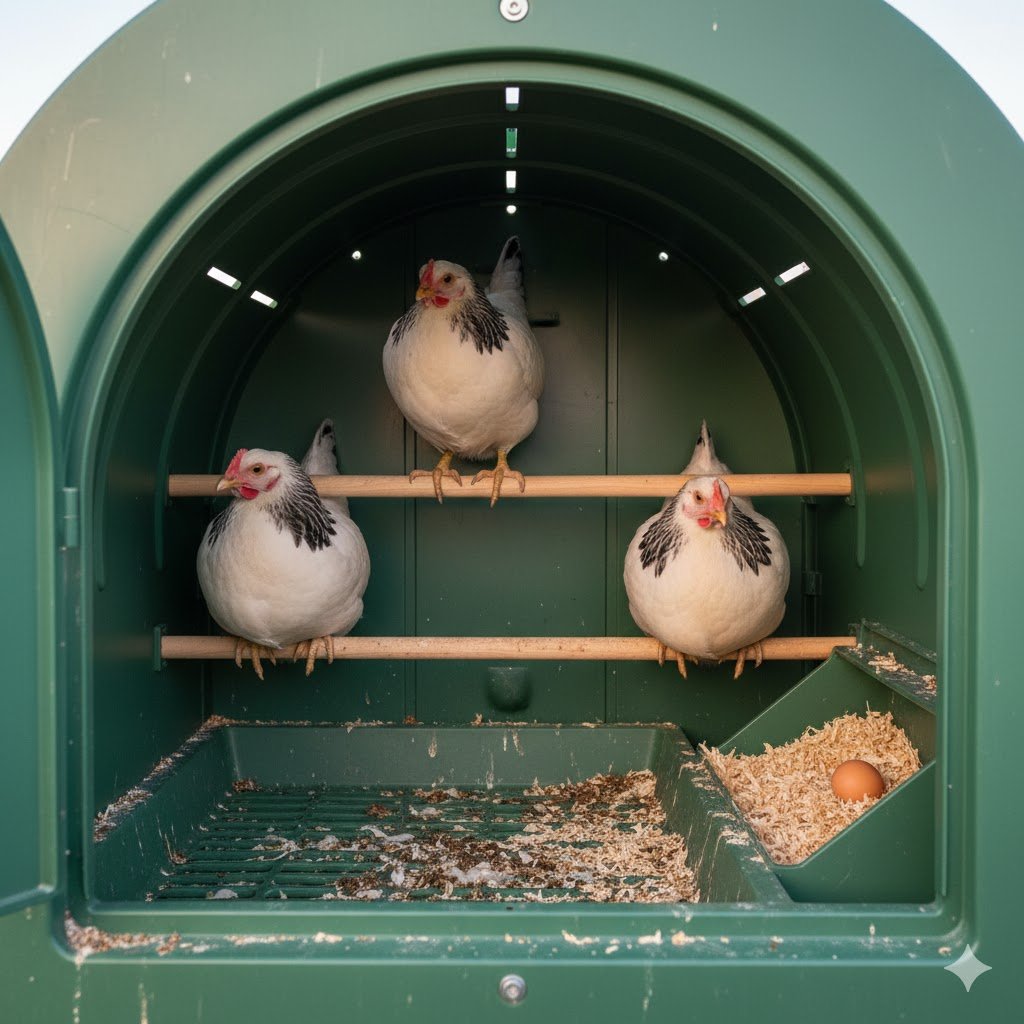
I’ve housed everything from my big Buff Orpingtons (lovely birds, but not the most prolific layers at around 180 eggs a year) to flighty bantam Leghorns. Six big Orpingtons was a bit of a squeeze, if I’m honest. But my current five hybrid hens, a mix including a Sussex (a reliable 250 light-brown eggs a year) and a Rhode Island Red (a workhorse, laying up to 280 brown eggs annually), have loads of room on the roosting bars and in the nesting box.
Space and Welfare Considerations
Remember that official poultry welfare guidelines are a key part of UK poultry welfare. While you’re only legally required to register your flock with DEFRA if you keep 50 or more birds, their welfare codes are the gold standard for all backyard keepers. Understanding how much space chickens really need helps you make informed decisions. For a detailed breakdown of all legal aspects, this comprehensive UK poultry keeping guide is an excellent resource.
The key to giving your birds a good life in the Cube is choosing the right run length options (they come in 2m, 3m, 4m etc.). If you’re still deciding, our guide on determining the right coop size can help. I wouldn’t recommend anything less than the 3-metre run for 4-6 birds if they don’t have much free-range time.
Knowing your birds are comfortable is one thing, but knowing they’re safe is even more critical, especially with the high level of need for UK fox protection.
Are Eglu Runs Rat Proof? Security Features Tested
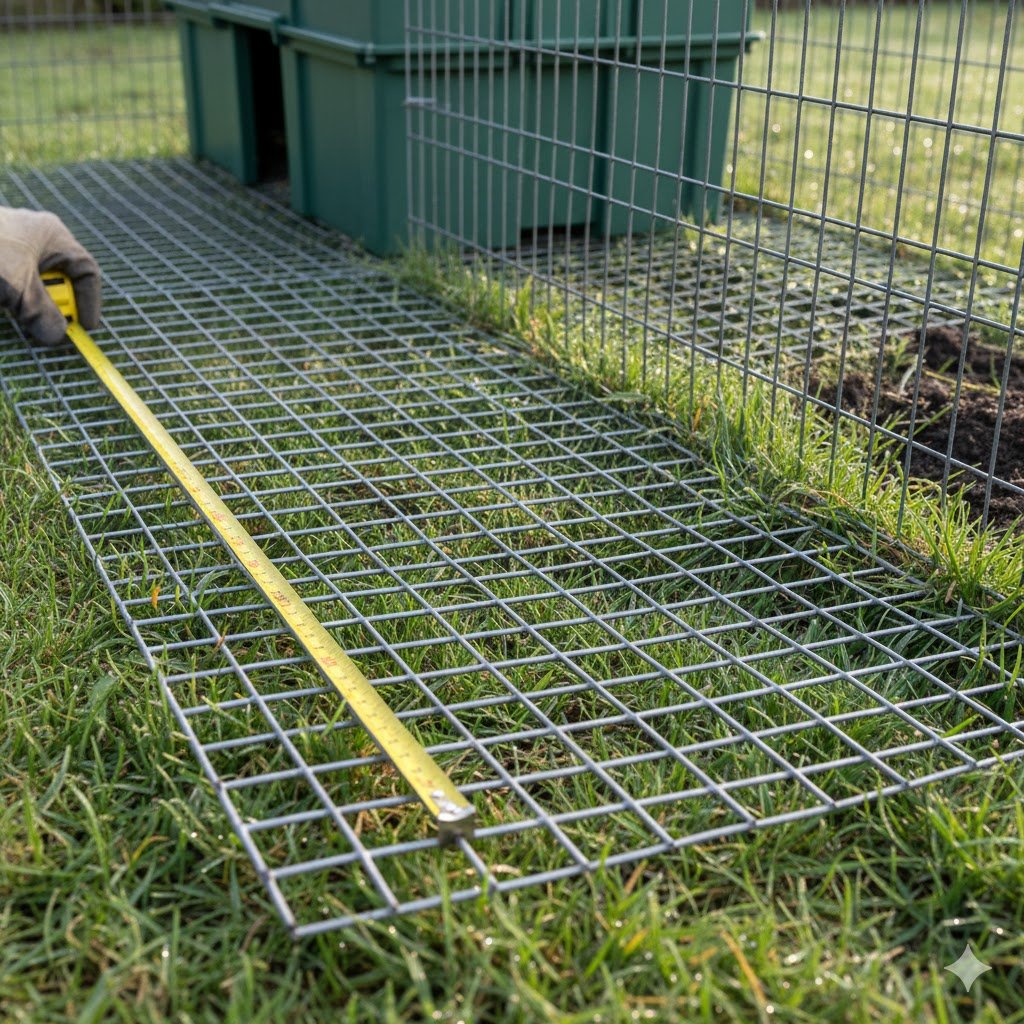
The Eglu Cube’s run is highly rat-resistant and fox-resistant due to its tough steel weld mesh and anti-tunnel skirt, but it’s important to know that no run is 100% rat-proof.
Living in the countryside, fox attacks are a constant worry, and the Eglu’s security is, for me, its best feature. Beyond the coop itself, consider these best predator deterrents for chickens to create multiple layers of security. This is a genuine fox-proof chicken house. I’ve seen muddy paw prints where a fox has tried to dig under and given up. However, rats are persistent diggers and can sometimes tunnel under the skirt if it’s not properly secured.
Are Omlet Runs Good? Build Quality Review
Yes, Omlet runs are extremely well-made and durable. The panels are made from heavy-gauge steel weld mesh, fully coated in a tough green plastic that prevents rust. After four years in the damp Devon weather, mine has no signs of corrosion. The clips are a bit fiddly during assembly, but once they’re on, they hold the panels together rigidly. It feels like a secure, quality product.
Fox-Proof Design Features
- The Anti-Tunnel Skirt: This is a simple but genius feature, and a key part of the British Hen Welfare Trust’s fox-proofing recommendations. The heavy-duty mesh extends outwards on the ground, so a predator has to start digging about a foot away from the coop wall. As recommended by UK coop suppliers, this skirt should lay flat on the ground.
- Secure Locks: The main coop door has a simple, effective twist-and-pull handle that is impossible for a predator to operate. You can also upgrade to an automatic door system.
- Rat-Resistant Mesh: The mesh size prevents rat intrusion. Because there’s no wooden floor to gnaw at, rats have no easy entry points. For more detailed information beyond the Eglu’s built-in features, see our guide on comprehensive rat prevention strategies. The biggest key to preventing rats, however, is always storing feed in secure containers outside the run.
This robust security makes the Eglu system particularly well-suited for those just starting out. Learn more about predator-proofing your chicken setup for complete flock protection.
Predator Testing Specifics
You mentioned fox paw prints—any other predator encounters? Absolutely. Living in Devon, we have a whole host of wildlife. I’ve had no issues with badgers trying to get in; the coop and run are too solid for them to bother with. I’ve also watched stoats and weasels investigate and move on, as they can’t get through the mesh. The biggest aerial threat, hawks and buzzards, are also kept out by the run’s roof mesh.
Is an Eglu Good for Beginners? Ease of Use Review
Yes, the Eglu Cube is an excellent choice for beginners because it eliminates common frustrations like red mites and difficult cleaning.
If you’re just starting your chicken-keeping journey, the Eglu Cube lets you skip most of the stressful lessons. You don’t have to become an expert on red mite treatment, you don’t have to worry if your coop is secure enough, and the cleaning is so simple you can’t get it wrong. Pair your beginner-friendly coop with one of the easiest chicken breeds for beginners for the smoothest start.
What Makes It Beginner-Friendly?
It’s a “coop-in-a-box” system. You get everything you need (except the chickens and feed) in one go. The integrated feeder and waterer are designed to minimise waste and stay clean, which is great for biosecurity measures.
This removes the guesswork and allows new owners to focus on the fun parts, like watching their hens chase a cabbage around the garden.
What About Omlet’s Customer Service?
I’ve only had to contact Omlet’s customer service once, shortly after I bought the coop. One of the feeder clips snapped (likely my fault for being too rough with it in the cold). I emailed them, and they sent a replacement part out within a few days, no questions asked. While some online reviews mention slow response times, my personal experience was quick and positive.
The biggest win for beginners, and indeed all keepers, is how it transforms the most dreaded chore: cleaning.
How Often Should I Clean My Eglu Coop? Maintenance Requirements
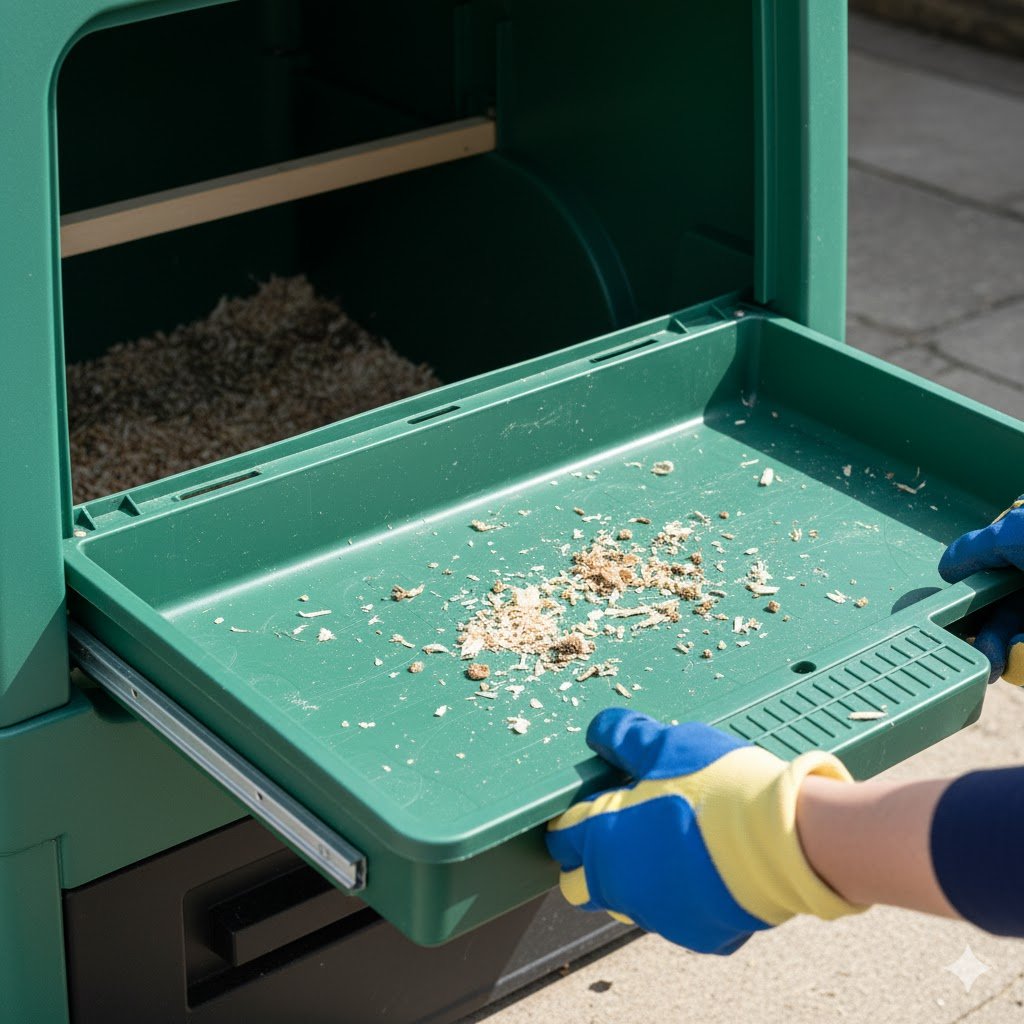
The Eglu Cube needs a quick clean once a week, a process that takes me only 5-10 minutes. This is a core feature that answers the question, “Is an Eglu chicken coop easy to clean?” with a resounding yes.
The design is so clever. Inside, there’s a large droppings tray that slides out. All the droppings fall onto it. This is my simple weekly maintenance routine. For additional tips, check out our complete guide on preventing coop odors.
5-Minute Cleaning Process Breakdown
- Slide out the tray: All the droppings are contained on the plastic tray.
- Empty into compost: I tip it straight into my compost heap.
- Quick wipe or hose down: A quick spray or wipe is all it needs.
- Slide it back in: That’s it. Job done.
Twice a year, I do a full deep clean, pressure washing the interior, which takes about 30 minutes. It’s a world away from the back-breaking scrub-out a wooden coop needs. While the Eglu’s plastic design resists odors naturally, some keepers also benefit from using barn lime in your coop for extra moisture control.
Does the Plastic Retain Odours?
This is a common question, and the answer is no, not if you clean it weekly. The plastic is non-porous, so unlike wood, it doesn’t absorb moisture or waste. The excellent ventilation helps keep the air fresh. In four years, my Eglu has never developed a lingering bad smell, which was a constant battle with my old wooden coops in the damp summer months.
This ease of maintenance is a year-round benefit, but how does the coop itself handle the distinct challenges of British seasons?
How Do You Keep an Eglu Warm in the Winter? UK Climate Testing
The Eglu Cube stays warm in winter thanks to its twin-wall insulation, which acts like double glazing to trap air and keep the cold out.
When winterizing chickens, this is a huge help. Chickens are surprisingly hardy, and their combined body heat in the insulated space keeps it well above freezing, even on the coldest nights. For a complete winterizing guide covering all aspects of cold-weather chicken care, see our comprehensive resource. The excellent ventilation system also helps with summer ventilation, preventing overheating.
Impact on Winter Egg Production
I’ve noticed a definite improvement in winter laying since switching to the Eglu. In my old wooden coop, egg production would drop to almost zero during the coldest snaps. In the Eglu, while laying still slows down as is natural, my hens keep going much more consistently. I believe the insulated, draft-free environment reduces stress on their bodies, allowing them to put more energy into egg-laying.
Managing Condensation: An Honest Tip
The one downside is that on very cold, still mornings, a little condensation can form on the inside roof. This is a common issue with plastic coops.
My tip is to ensure the ventilation slots are always clear. On the coldest days, cracking the main door open just a tiny bit can also increase airflow and solve the problem. It handles a damp, chilly British winter beautifully.
While its performance in static conditions is excellent, one of its best features is the ability to not be static at all.
Can You Move an Omlet Eglu Easily? Portability Review
Yes, with the optional wheel kit, the Omlet Eglu Cube is easy for two people to move, turning it into a ‘chicken tractor’ or portable chicken run.
My lawn used to get wrecked by muddy runs. Now, every weekend, I get my husband to help me wheel the Eglu to a fresh patch of grass. This gives the chickens new ground to forage on and stops one area from turning into a mud pit. If the Eglu’s price is too steep but you love the portability concept, explore DIY chicken tractor options as an alternative.
Is it a One-Person Job?
Honestly, moving it is much easier with two people. The wheels are sturdy, but the run is long and can be a bit awkward to navigate around corners by yourself.
If you have a flat, simple garden, one person can manage, but for most, it’s a quick two-person task. This portability is a huge advantage over a heavy, static wooden coop.
Expansion Options: Growing Your Flock
A great feature of the modular coop system is that you can extend the run later if you decide to get more chickens or just want to give your current flock more space. Omlet sells 1-metre run extensions that are easy to add on. However, you can’t directly connect two Eglu Cubes together to form one giant coop; they are designed as standalone units.
All these features sound great, but they come at a price. It’s time to tackle the elephant in the room: the cost.
Is the Omlet Eglu Worth the Money? Cost Analysis for UK Keepers
Yes, the Omlet Eglu is worth the money if you prioritise saving time, high security, and long-term durability over a high initial cost.
It’s a lot of money (£1,122 for the complete setup as of October 2025), and I won’t pretend it isn’t. But here’s how I justified it to myself over 10 years compared to budget chicken coops:
- My Last Wooden Coop: £400 (initial) + £20/year for treatment (£200) + had to replace it after 6 years (£400) = £1,000. And that’s not counting my time or the money I spent on mite powder.
- Eglu Cube: £1,122 initial cost. That’s it.
When you look at it that way, the cost is much closer than you think. You’re paying upfront for a decade of less work, less stress, and healthier chickens. For me, that was worth it.
Pros & Cons
| Pros | Cons |
|---|---|
| ✅ Cleaning is ridiculously fast and easy | ❌ The price tag is a real gut-punch |
| ✅ Top-notch protection from foxes | ❌ The assembly will test your patience |
| ✅ Basically red mite proof | ❌ Let’s face it, it looks like a plastic igloo |
| ✅ Built to survive the British weather | ❌ Condensation can happen on very cold mornings |
| ✅ Easy to move to protect your lawn | ❌ The add-on accessories are also pricey |
Comparison to Alternatives
In the UK market, the main Nestera vs Omlet debate is a big one. Both offer high-quality plastic coops. Before deciding, consider whether a chicken tractor vs stationary coop comparison might influence your choice. Here’s how the Cube stacks up against a typical wooden coop and Nestera’s equivalent model.
| Feature | Eglu Cube | Traditional Wooden Coop (e.g., a Kent Fowl House) | Nestera Lodge (Large) |
|---|---|---|---|
| Price | £1,122+ | £300-£600 | £800-£900 |
| Lifespan | 15+ years | 5-7 years | 10+ years |
| Cleaning Time | 5 minutes | 20-30 minutes | 10 minutes |
| Red Mite Risk | Very Low | High | Very Low |
| Predator Security | Excellent | Variable | Excellent |
| Warranty | 10 years | 1-2 years | 25 years (on recycled plastic) – see this independent Nestera review |
Where to Buy & Pricing
The best and safest place to buy is direct from Omlet’s UK website. That way, you’re covered by their 10-year warranty.
You sometimes see them second-hand, but they hold their value so well you don’t save much. It’s important to remember Omlet is a British company founded in 2004 and based in Oxfordshire. While their products are designed in the UK for British conditions, manufacturing takes place overseas in China.
Common Complaints & Issues
No product is perfect. Some reviewers complain about condensation on very cold mornings. While I have seen a little bit of this, I found it’s never been enough to cause a problem, and making sure the vent is clear helps.
The biggest complaint is always the assembly. And of course, the price. These are valid points, but for me, they are minor compared to the constant threat of rot and red mites in my old wooden coops.
Final Verdict: Is the Omlet Eglu Cube Worth It?
So, here’s my final take. After years of use, I can honestly say that for my situation, the Omlet Eglu Cube was worth every penny. But it isn’t for everyone.
You should buy the Eglu Cube if:
- You’re like me and would rather spend Sunday morning with a cup of tea watching your hens than scrubbing a coop.
- You live where foxes are a real threat and you want to sleep soundly.
- You are a beginner and want to start off on the right foot.
- You see it as a 10+ year investment in your hobby.
You should look at alternatives if:
- You have a strict budget that just won’t stretch that far.
- You genuinely enjoy the rustic look and maintenance of a wooden coop.
- You have a very large flock (more than 6-8 large birds).
For most UK backyard chicken keepers, I believe it’s a brilliant investment that repays you with time and peace of mind.
Frequently Asked Questions (FAQ)
Q: Is the Omlet Eglu worth the money?
A: In my opinion, yes, if you value your time and want a low-maintenance, highly secure coop. Over 10 years, its cost is very similar to buying and maintaining a wooden coop, but with far less work involved.
Q: How long does an Omlet Eglu last?
A: You can expect an Eglu to last for 15+ years. It’s made of a tough plastic that doesn’t rot or degrade in the sun, and Omlet backs it with a 10-year warranty, which is a great sign of its quality.
Q: How many chickens fit in an Eglu Cube?
A: It comfortably fits up to 6 large hens, like Orpingtons, or up to 10 smaller bantam chickens. I’d say 5-6 large birds is the sweet spot to ensure they have plenty of roosting space.
Q: Are Eglu runs rat proof?
A: They are highly rat-resistant, but not 100% rat-proof. The steel mesh and anti-tunnel skirt are excellent deterrents. However, determined rats can sometimes dig under the skirt, so it’s best to secure it with soil or pavers and never leave food in the run overnight.
Q: Is an Eglu good for beginners?
A: Yes, it’s fantastic for beginners. It helps you avoid the biggest headaches like red mites and complicated cleaning, letting you enjoy the best parts of keeping chickens right from the start.
Q: Where are Omlet products made?
A: Omlet is a British company based in Oxfordshire, where they design all their products for UK conditions. To maintain their design quality while managing costs, the coops are manufactured in China.
Conclusion
The Omlet Eglu Cube isn’t just a place for your chickens to sleep; it’s a well-thought-out system to make your life easier. Yes, the price is steep, but its long-term value and incredible ease of use make it a wise choice for most UK keepers.
It solved every frustration I had with my old wooden coops.
I hope my honest ramblings have helped you make your decision! I’ll keep this article updated if my opinions change. Feel free to share your own experiences in the comments!

Oladepo Babatunde is the founder of ChickenStarter.com. He is a backyard chicken keeper and educator who specializes in helping beginners raise healthy flocks, particularly in warm climates. His expertise comes from years of hands-on experience building coops, treating common chicken ailments, and solving flock management issues. His own happy hens are a testament to his methods, laying 25-30 eggs weekly.
